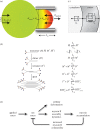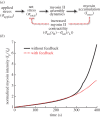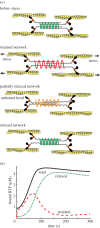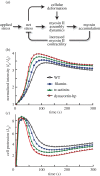Cell shape regulation through mechanosensory feedback control
- PMID: 26224568
- PMCID: PMC4535415
- DOI: 10.1098/rsif.2015.0512
Cell shape regulation through mechanosensory feedback control
Abstract
Cells undergo controlled changes in morphology in response to intracellular and extracellular signals. These changes require a means for sensing and interpreting the signalling cues, for generating the forces that act on the cell's physical material, and a control system to regulate this process. Experiments on Dictyostelium amoebae have shown that force-generating proteins can localize in response to external mechanical perturbations. This mechanosensing, and the ensuing mechanical feedback, plays an important role in minimizing the effect of mechanical disturbances in the course of changes in cell shape, especially during cell division, and likely in other contexts, such as during three-dimensional migration. Owing to the complexity of the feedback system, which couples mechanical and biochemical signals involved in shape regulation, theoretical approaches can guide further investigation by providing insights that are difficult to decipher experimentally. Here, we present a computational model that explains the different mechanosensory and mechanoresponsive behaviours observed in Dictyostelium cells. The model features a multiscale description of myosin II bipolar thick filament assembly that includes cooperative and force-dependent myosin-actin binding, and identifies the feedback mechanisms hidden in the observed mechanoresponsive behaviours of Dictyostelium cells during micropipette aspiration experiments. These feedbacks provide a mechanistic explanation of cellular retraction and hence cell shape regulation.
Keywords: cell shape regulation; force feedback; mechanosensing; myosin II.
© 2015 The Author(s).
Figures





Similar articles
-
Mechanochemical Signaling Directs Cell-Shape Change.Biophys J. 2017 Jan 24;112(2):207-214. doi: 10.1016/j.bpj.2016.12.015. Biophys J. 2017. PMID: 28122209 Free PMC article. Review.
-
Mechanosensing through cooperative interactions between myosin II and the actin crosslinker cortexillin I.Curr Biol. 2009 Sep 15;19(17):1421-8. doi: 10.1016/j.cub.2009.07.018. Epub 2009 Jul 30. Curr Biol. 2009. PMID: 19646871 Free PMC article.
-
Mitosis-specific mechanosensing and contractile-protein redistribution control cell shape.Curr Biol. 2006 Oct 10;16(19):1962-7. doi: 10.1016/j.cub.2006.08.027. Curr Biol. 2006. PMID: 17027494 Free PMC article.
-
Understanding the cooperative interaction between myosin II and actin cross-linkers mediated by actin filaments during mechanosensation.Biophys J. 2012 Jan 18;102(2):238-47. doi: 10.1016/j.bpj.2011.12.020. Biophys J. 2012. PMID: 22339860 Free PMC article.
-
Dictyostelium cytokinesis: from molecules to mechanics.J Muscle Res Cell Motil. 2002;23(7-8):719-27. doi: 10.1023/a:1024419510314. J Muscle Res Cell Motil. 2002. PMID: 12952070 Review.
Cited by
-
Specific prostaglandins are produced in the migratory cells and the surrounding substrate to promote Drosophila border cell migration.bioRxiv [Preprint]. 2023 Jun 26:2023.06.23.546291. doi: 10.1101/2023.06.23.546291. bioRxiv. 2023. Update in: Front Cell Dev Biol. 2024 Jan 12;11:1257751. doi: 10.3389/fcell.2023.1257751. PMID: 37425965 Free PMC article. Updated. Preprint.
-
A continuum model of mechanosensation based on contractility kit assembly.Biophys J. 2025 Jan 7;124(1):62-76. doi: 10.1016/j.bpj.2024.10.020. Epub 2024 Nov 8. Biophys J. 2025. PMID: 39521955
-
The mechanobiology of actin cytoskeletal proteins during cell-cell fusion.J R Soc Interface. 2019 Jul 26;16(156):20190022. doi: 10.1098/rsif.2019.0022. Epub 2019 Jul 24. J R Soc Interface. 2019. PMID: 31337301 Free PMC article.
-
Mechanochemical Signaling Directs Cell-Shape Change.Biophys J. 2017 Jan 24;112(2):207-214. doi: 10.1016/j.bpj.2016.12.015. Biophys J. 2017. PMID: 28122209 Free PMC article. Review.
-
Chemical characterization of non-psychoactive Cannabis sativa L. extracts, in vitro antiproliferative activity and induction of apoptosis in chronic myelogenous leukaemia cancer cells.Phytother Res. 2022 Feb;36(2):914-927. doi: 10.1002/ptr.7357. Epub 2022 Feb 2. Phytother Res. 2022. PMID: 35107862 Free PMC article.
References
Publication types
MeSH terms
Substances
Grants and funding
LinkOut - more resources
Full Text Sources
Other Literature Sources

